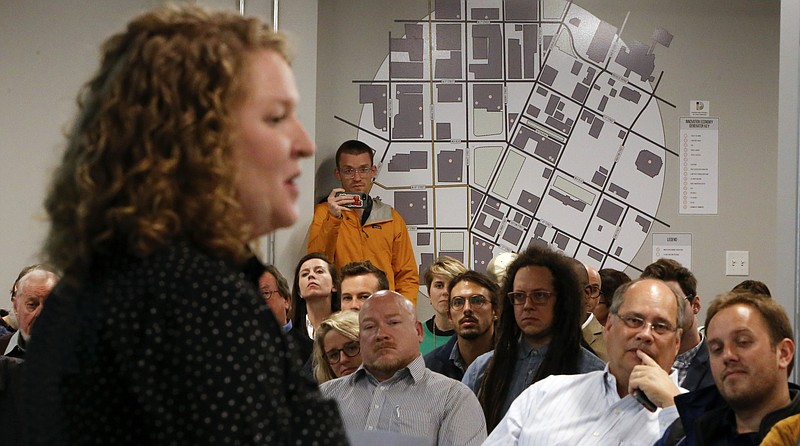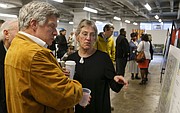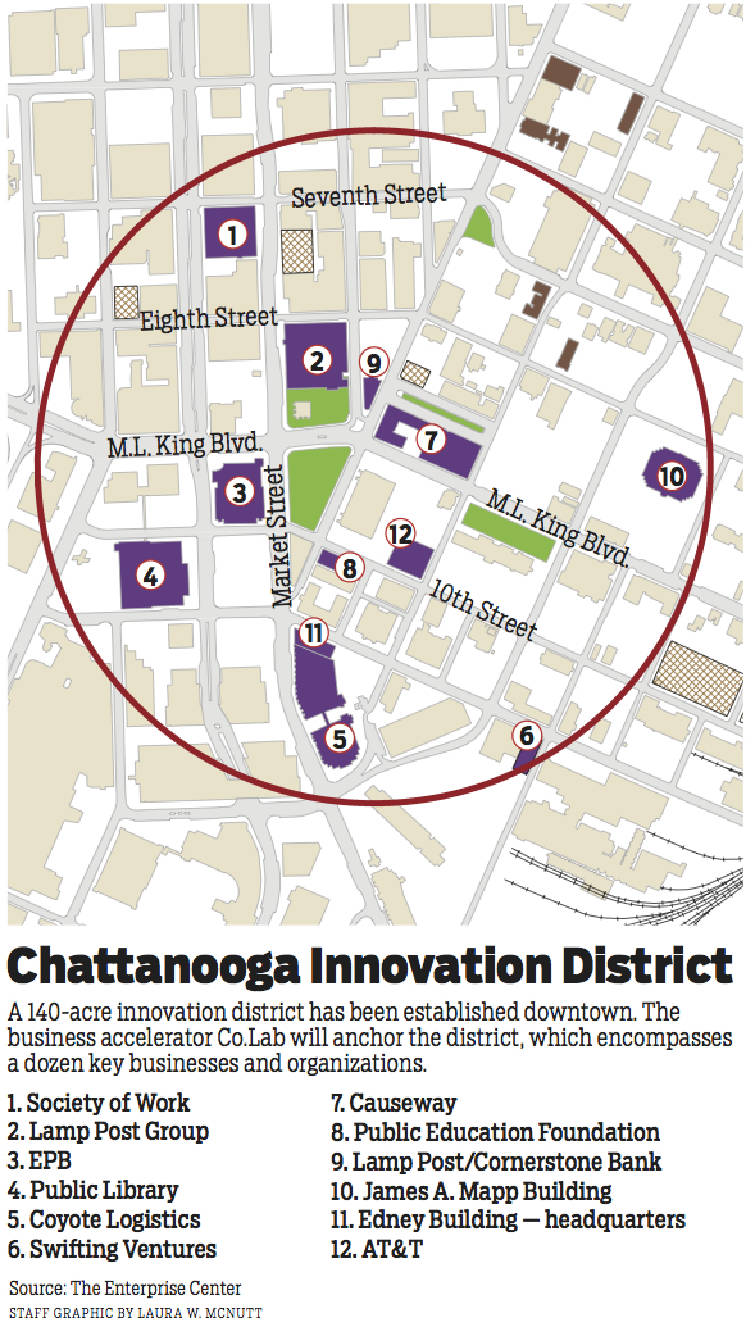A new vision for Chattanooga's Innovation District calls for a better University of Tennessee at Chattanooga presence downtown, adding affordable housing and modern office space and using the area as a test bed for research.
The six-month-long study, released Tuesday, of the future of the 140-acre downtown district also cites the need for more access to investors and skilled labor and improved industry-education ties, among an array of ideas.
"We have created a place where people feel comfortable, [but] now is no time for a victory lap," said Chattanooga Mayor Andy Berke. "We have a chance to take it to the next level. This is the right plan for us."
Chattanooga's Innovation District was created in 2015 in the heart of the city center and has drawn global attention. The aim was to develop a place where entrepreneurs, tech-based startups, and business incubators can mesh and create a so-called innovation ecosystem.
The Edney Building at Market and East 11th streets was renovated and turned into a hub for the district in the effort to grow the city's knowledge economy.
What’s next
In coming weeks, an implementation plan with recommendations is expected to be developed after working with stakeholders in the Innovation District, said Ken Hays, who heads the city’s Enterprise Center.To see more, go to framework.chainnovate.com.
The $140,000 study paid for by the city and overseen by its Enterprise Center was unveiled before about 150 people. It examines the district in three parts and raises ideas that could be developed over the next five to 10 years:
» Civic Crossroads: Located on the west end of M.L. King Boulevard, it contains major anchors such as Miller Park, the Public Library, EPB, and the Krystal and Tallan office buildings. The study said this area contains underused buildings, a lack of active ground floor uses and vacant land.
The report suggests a new office and research building on the Civic Forum Block at Market and West 11th streets.
Also, the Krystal and Tallan buildings could become mixed-use collaborative office spaces, including labs that bring together educators, researchers, students and others.
"Establishing a UTC presence in this area would be ideal," the report said.
In addition, the streets, plazas and parks in this part of the district could showcase the work of artists and entertainers, according to the study.
» Downtown Campus: Located on the east end of M.L. King in the district, this area also has a large number of under-utilized buildings and vacant land, as well as a concentration of city government properties.
The study calls for redeveloping the block where UTC's James A. Mapp Building sits. The block could hold new buildings to serve the university on upper floors while offering retail and commercial space on the ground level. A UTC-affiliated hotel also could go on this block, the study suggested.
Also, this area in the district could hold more housing for all income levels, such as areas around City Hall and near the Bessie Smith Cultural Center, the report said.
Also, property owners in the area, such as AT&T, could explore repurposing underused structures, it said.
» M.L. King Cultural Corridor: The report said the most successful Innovation Districts are not only hotbeds of research and entrepreneurism, but have strong cultural identities.
"They are places people want to go to socialize, be entertained, learn new things and experience diverse social settings," the study said.
It termed M.L. King Boulevard connecting downtown to UTC and the adjoining neighborhood as "among the city's most important cultural assets."
The report said the Bessie Smith Cultural Center is making plans, and there's potential to upgrade and better position it on that block to create a more dense, mixed-use development.
In addition, there's interest in using the M.L. King corridor as a test bed with the help of UTC and EPB. The site could be used in transportation, air quality and wireless communications research, the study said.
___
Hamilton County Mayor Jim Coppinger said he's excited to see the educational component in the study. He said it's important to have the public school system plugged into the district, as well as UTC and Chattanooga State Community College.
UTC Chancellor Dr. Steve Angle termed the plan "a great vision of a lot of pieces that can come together." Angle said the development of Chattanooga's waterfront over the years could be a model of what could occur in the Innovation District.
"What we have seen today can be," he said.
Helen Burns Sharp of the Accountability for Taxpayer Money citizens group said the plan is "ambitious, causing us to look differently at places and spaces that could use a shot in the arm."
She said the district's footprint, such as the riverfront and the Southside, is already on the active radar screen of private developers and that "I hope the city and county will be careful if approached for tax incentives" such as tax-increment financing or payment-in-lieu-of-taxes agreements.
David Ramsey, who grew up in Chattanooga and then moved away, said he's thinking of coming back to the city.
"It's not the Chattanooga I grew up in," he said.
Chattanooga developer and former mayor Jon Kinsey said the plan appears to offer "great opportunities" for private developers.
Contact Mike Pare at mpare@timesfreepress.com or 423-757-6318.


